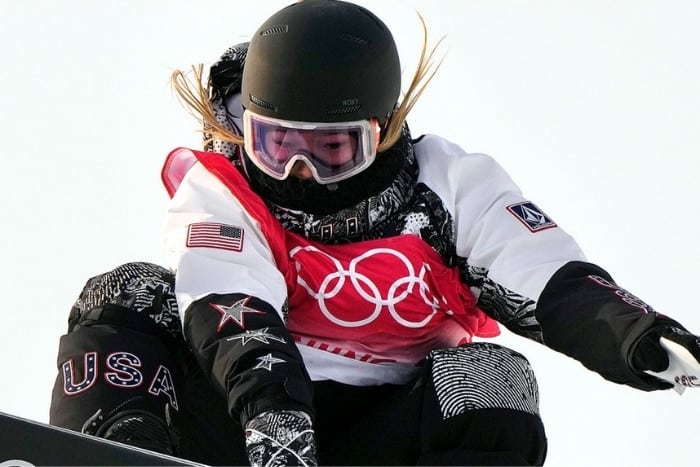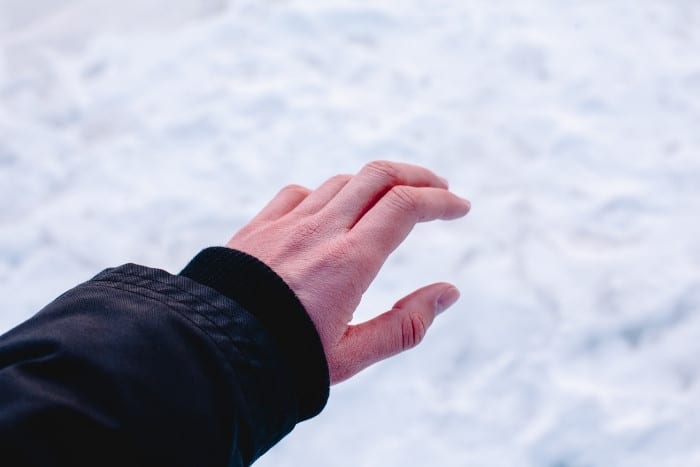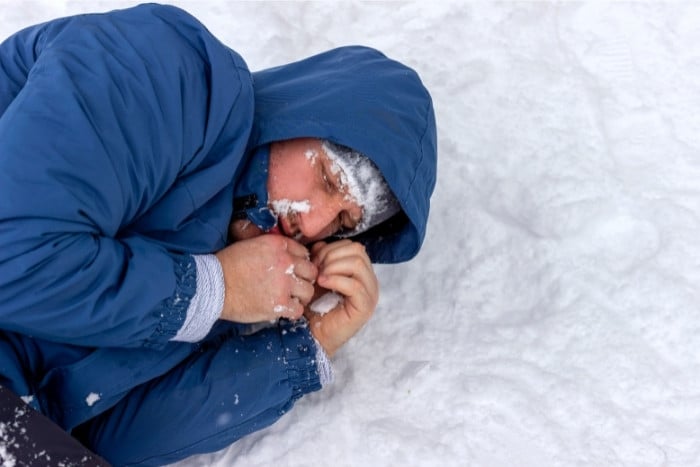Something rather strange happened during the Winter Olympics: athletes tucked their bibs under their arms in a move now known as the one-arm method. Why did they do this?
Snowboarders wear bibs on one shoulder as a safety measure, as the bibs can flap around and block their vision when performing tricks. When tucked under the arm, the chances of this occurring are very low. This is not standard practice, but it is an effective maneuver for some top athletes.
What are other interesting ways winter athletes have tried to keep themselves safe? Once you’re aware of the dangers, you might even appreciate these creative endeavors.
The Reason for Wearing Bibs on One Shoulder
You might have noticed that during the Beijing Winter Olympics, many snowboarders tucked their bibs under their shoulders.
The reason is that these bibs can be dangerous as they can easily fly over the face blocking the snowboarder’s vision during their run. Hence, many athletes take the safer choice of just tucking them under their arms.
Although not widely accepted as a standard practice, some of the world’s best snowboarders used the one-arm method, so at least you know it’s effective.
1. Why Do Athletes Wear Bibs in the First Place?
The Olympics attract sports people from all corners of the world. Naturally, you can expect a lot of athletes, and identifying them can become a nightmare for the judges and officials.
Hence, the numbers were used to identify participants. Bibs are a piece of clothing that goes over a snowboarder’s outerwear to identify them.
Numbers were printed on bibs or sometimes kept in place using safety pins. But computers have made this practice unnecessary, as modern bibs can use electronic chips for identification.
Today, besides Olympic bibs used for identification, bibs are also in place to support sponsors in many competitions. These sponsors pay big money to athletes to market themselves on big screens.
Their logo appearing on the chests of athletes in an international event can bring in a lot of views and customers to businesses.
Hence they are always happy to support and sponsor many participants.

2. Nike’s New Bib Design
The traditionally styled bibs tend to flap around a lot, which can be bad news for people in many different types of sports. Blocked vision can be annoying and dangerous while competing.
So, Nike, back in 2016, decided that they would redesign the bibs for Olympic runners and completely remove the safety pins.
The result was a bib named AeroSwift, which sticks to the runner’s clothing or skin, eliminating flaps or drag from the wind, making it aerodynamic and faster.
While these are only available for runners at the moment, perhaps, one day, we will get similar bibs that stick on clothing for snowboarders.
But for the time being, snowboarders will have to continue to be innovative with the materials available to them, which brings us to our next point.
3. Face Taping, Another Interesting Phenomenon
Difficult sporting conditions force athletes to try new things to cope with the weather. You thought tucking away bibs under the arms was odd?
At the recent Winter Olympics, snowboarders were covering their faces with tape to protect their skin from the cold. It’s called a kinesiology tape.
The tape is elastic, easy to use, and sticks to the skin. An interesting thing to note is that this is the same tape many athletes use for muscle support.
From face value, these measures might seem funny to an average fan, but you have to remember that frostbite is a serious concern in some parts of the world.
And a Beijing winter is no exception. People compete against each other in freezing conditions, with temperatures hitting around -17 Celsius (1.4°F), causing concern for frostbite.
4. Manufacturers’ Opinion on This Move
What’s the expert opinion on this makeshift move, though?
The manufacturers are very clear about how the tape is supposed to be used: they don’t endorse it as it has not been clinically evaluated to protect against the cold.
But they do appreciate the creative efforts of the athletes.
There is also the opinion that the tape acts as a protective barrier against the wind and is particularly useful for snowboarders who shred at high speeds.
Though, a strong word of caution is that people who are allergic to the adhesive used in the tapes can develop skin conditions that can result in severe symptoms such as swelling and irritation.
Yep, the tape is easy to use but not so easy to remove! Removing the tape is like removing a very sticky band-aid, so you can essentially be ripping away your top layer of the skin.
And the benefits can sometimes outweigh the risk, so if you are getting ideas from watching the Olympics, we would most certainly advise against it.
Though, if you’re looking to keep yourself warm as a snowboarder in extreme weather, we have something for you to avoid frostbite.
Frostbite – Catch It at An Early Phase
Once you have a good understanding of what frostbite is, you will be able to see through its symptoms and take necessary precautions to stop its spread.
Frostbite advances from its earliest stage (frostnip) to its much more severe form (late-stage frostbite). Here is a brief overview of all the stages so you can stay alert.
1. Frostnip
This is the initial stage of frostbite. The telltale signs are pale or red skin, a tingling sensation in the area, or loss of sensation.
At this stage, the odds of permanent damage are less, but it’s a race against time as it can quickly progress to the following stages before you know it.
2. Superficial Frostbite
At this phase, the liquids beneath the skin start freezing under extreme cold. You might feel a deceiving sensation of warmness under your skin, but it is still cold to the touch.
The symptoms are similar to frostnip, but when treated at this stage, there are usually other side effects such as swelling and blisters
3. Severe Frostbite
Also known as the late-stage frostbite. Multiple layers of skin are affected, including the tissue beneath the skin. It is unique in that the skin turns white or gray, and there is no sensation in the area.
The skin gradually turns black and hardens as the damage is permanent.

How Can You Protect Yourself from Frostbite?
Now that you know how to spot frostbite before it takes hold. How can you protect yourself against frostbite when hitting the slopes? Here are some precautions.
1. Look Out for Colder Weather
One of the easiest ways to prevent frostbite is to keep an eye out for the weather on the day you plan to hit the slopes.
Although you might be very eager to hit the slopes in freezing weather as the hill is likely less crowded, there is also a higher risk of getting frostbite.
Always remember, whenever the temperature is below zero degrees Celsius (32°F), there is a high chance of frostbite.
Likewise, even colder temperatures dramatically increase the chances of getting afflicted.
Pay attention to how strong the winds are, as these can lower your body temperature even further when shredding down the slopes.
Always check the weather conditions for the day before venturing out to the mountains just to be safe.
2. Don’t Forget Your Protective Gear
As I mentioned, if you are sure you’re going to face severe winds and plan on riding for a long time, you should buckle up in your full protective gear.
You need goggles, a beanie, and face masks to protect your skin from freezing cold winds.
Snowboarding jackets, pants, and socks are essential, and these should be worn over long underwear and light fleece for extra protection.
A helmet helps in keeping your ears and head warm. With these, you are set to take on the cold!
3. Continually Monitor for Symptoms
As you might already know, snowboarding is a physical activity that generates heat for your body. This heat will help you stay warm and reduce the chance of frostbite.
But there is always a chance that you might develop frostbite despite the heat generated from activity. So your physical activity for the day plays a role in keeping you warm.
Also, remember that detecting early-stage frostbite can be hard because of the loss of sensation you might experience.
Therefore, it is advisable to be alert and look out for the symptoms before you hop on the lift after every run.
4. How to Manage if the Worst Happens
Let’s just assume the unfortunate thing happens, and you get the symptoms of frostbite. Follow these safety measures to immediately arrest the spread and save your skin from permanent damage.
You Need to Warm Up Fast
Once you start noticing the symptoms, immediately move to someplace warm.
After warming up a bit, you need to remove all the wet clothes that can reduce your body temperature and replace them with dry fabrics.
However, most of the time, when frostbite strikes, snowboarders are out on the mountain. In this case, the best thing to do is to cover the affected area with thick clothing to prevent cold exposure.
And think about rewarming once you are in a warm spot.
When warming, apply warm water gently across the affected area without putting too much force as frostbite makes the skin very sensitive to pressure, and you might do more harm than good.
Doctors to Your Rescue
There is only so much we can do before we need to seek the help of medical professionals. If your frostbite is any worse than frostnip, you should seek help from a health provider.
But there is no harm in seeking help at earlier stages, as some might have trouble identifying the correct symptoms associated with each stage.
Still, initial signs of frostbite, such as frostnip, can be taken care of without medical intervention using the warming-up method. You will recover without any permanent damage to your skin.
If you notice a slight sensation loss in the area, immediately seek help. This is usually the sign of progression from earlier to severe stages of frostbite.
Hypothermia – Another Closely Related Medical Condition
You thought frostbite was scary? We simply couldn’t cover frostbite without covering another closely related medical condition, hypothermia.
Hypothermia occurs when your body loses heat quickly and cannot regain its normal body temperature.
When it slips below 35 degrees Celsius (95°F), the heart, nervous system, and other organs can’t function normally, eventually leading to death if not treated.
Frostbite and hypothermia are related in that extremely cold weather is the number one risk factor for them. So, what are the signs of hypothermia?
1. Mild Hypothermia
Shivering is the number one sign that you should be alert of. This is one of the natural mechanisms the body uses to fight against cold temperatures.
As when you shiver your muscles involuntarily, you start producing heat. You might also feel extremely fatigued and lose interest in riding altogether as even walking becomes difficult.
This initial stage usually happens when you are in wet clothes and feel extremely cold.

2. Moderate to Severe Hypothermia
Moderate to severe hypothermia happens when your body temperature drops below 32 degrees Celsius (89.6°F).
Symptoms associated with moderate to severe hypothermia include decreased brain and heart function, decreased reflexes, and a loss of memory, awareness, and motor skills.
You must seek medical help at this stage, as this could become a medical emergency.
3. How is Hypothermia Treated?
The type of treatment of hypothermia depends on its severity.
When experiencing mild hypothermia, you only need to safeguard yourself from further cold exposure by removing yourself from cold conditions.
Your body can take care of the rest as humans can generate their own heat. This is done by insulating the affected person with dry clothes and keeping them in a warm environment.
In advanced stages, the body is unable to regain heat fast enough to avoid damage and requires external heat sources to kick start the process.
To do this, remove any wet clothing, wrap the person in a warm blanket, and provide them with a warm drink.
Call your local ski patrol or emergency services, and monitor the person’s breathing until help arrives. Now we believe you can understand how serious things can get from cold exposure.
One certainly cannot blame the athletes for trying creative ways to keep them safe under difficult circumstances, but is it effective or clinically approved?
Only additional research can tell, but at the moment, these methods just seem to work.
Final Thoughts
Athletes do their best to keep themselves safe. Tucking away the bibs under the arms stops them from flapping around from strong winds or performing insane tricks that can block the snowboarder’s vision.
So they tuck their bibs as a safety precaution. Other creative ways to overcome difficulties faced during snowboarding include using tape to protect the skin from extreme cold.
There can be dramatic consequences if you don’t take care of yourself during harsh winter climates. Thumbs up for human ingenuity!
